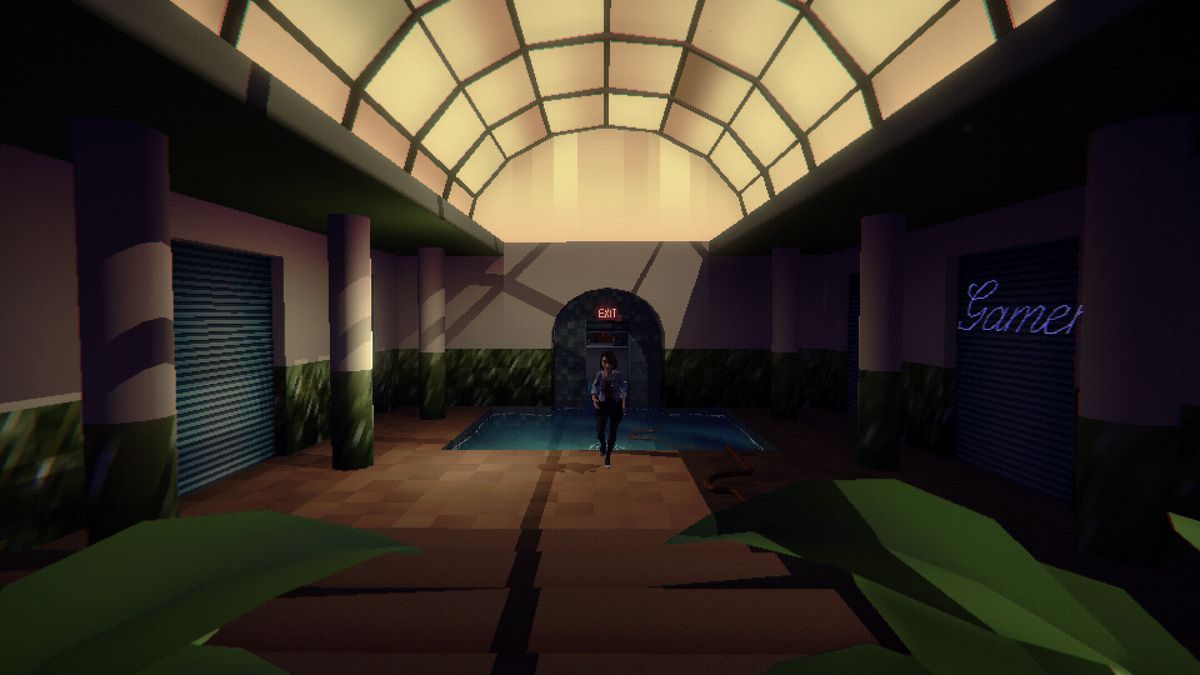Horror is a vast genre, ranging from blood-soaked slasher films to strange and cerebral campfire stories. Homebody, published by Rogue Games and developed by Dream Daddy: A Dad Dating Simulator studio Game Grumps, tends toward the latter. I assume the role of Emily, a young woman with agoraphobia — an isolating, suffocating fear of leaving one’s safe place and awkward, embarrassing, or uncomfortable experiences.
I’m in an isolated house full of friends, rented out over the years by an eccentric writer, when the power unexpectedly cuts out. After a few jokes about the horror movie atmosphere, I check the power box, which is weirdly empty — there are just two cords, one leading up to the attic and one to the cellar. These are also areas of the house that we’re forbidden from entering by the absent homeowner. Just as I resign myself to checking out the basement, I’m stabbed to death by a mysterious masked figure.
But then the clock reverses, and I’ve just arrived at the house again. I try to bring this experience up with my friends through dialogue trees when we chat, but it doesn’t matter how hard I try to warn them — it’s just filtered into banal small talk. Homebody mixes the primal fear for one’s life with the much less intense (but more relatable) fear of awkward conversations, strained friendships, and people being mad at you.

Homebody joyously draws inspiration from PlayStation-era survival-horror games, with fixed camera angles and polygonal graphics. Emily isn’t gifted in combat, and as such, my best option for dealing with the killer is simply to hide in a closet or run away. Cutscenes and flashbacks punctuate Homebody, depicting Emily’s social anxiety. She has been isolating herself over the last year, and it’s a growing source of resentment for her friends.
Making matters worse, the gentleman who owns the house that my friends rented is eccentric. There are locks and keypads everywhere. I find a note on a desk that corresponds to a letterbox; if I open that, I find a color code, which can be used to adjust a machine in the basement to unlock another door.
These puzzle chains make up the challenge of Homebody; I have to find clues and solve riddles while dealing with the pressure of avoiding a masked murderer. When I die, the clock rolls back to the beginning of the night. I retain my memories, however, which are helpfully sorted and cataloged in a memory log. As I progress, the time loop starts to break down. Other characters give signs that they, too, are aware of the horrible fate they’re about to endure. The killer shows up earlier in the night, breaking the routine.

The masked murderer and creepy house is just a reason to explore the tension between Emily, her agoraphobia, and her friends. As such, Homebody isn’t about the immediate terror of being stabbed, but the slow decay and isolation brought on by her agoraphobia. The game plays on the anxiety of reuniting with people who might be mad at you, and worse yet, their feelings might be justified. As Emily struggles to survive the murderer, she also has to go through the ordeal of honest relationships with friends she hurt.
While the writing is intriguing, the mechanics can be awkward at times. The fixed camera and tanky controls meant that I often dillied around a door, going back and forth between two rooms unintentionally. There’s also only one master volume bar in the settings, which is awkward when the sound effects are a little too loud. Half of Emily’s friend group feels a little unnecessary, like they’re just there to round out the cast. A couple of friends end up playing a major part in Emily’s past, and her catharsis comes from exploring those relationships. Others in the house are just there to add commentary to the relationships that matter, before getting murdered to ramp the tension. As such, it feels like there’s a little too much filler between the setup and the payoff of this particular story.
These small but persistent issues aren’t deal breakers, but they cut the tension. Homebody didn’t terrify me to my core, but I still found myself compelled to uncover its secrets, and it only takes a few hours to complete. The plot leaves key points up for interpretation, and as such, this is the sort of game that I’ll be digesting for quite some time. It’s not the same brand of horror as jump scares or gory deaths, but it’s unnerving all the same.
Homebody was released on June 1 on Nintendo Switch, PlayStation 4, PlayStation 5, Windows PC, Xbox One, and Xbox Series X. The game was reviewed on PC using a download code provided by Rogue Games. Vox Media has affiliate partnerships. These do not influence editorial content, though Vox Media may earn commissions for products purchased via affiliate links. You can find additional information about Polygon’s ethics policy here.
- SEO Powered Content & PR Distribution. Get Amplified Today.
- EVM Finance. Unified Interface for Decentralized Finance. Access Here.
- Quantum Media Group. IR/PR Amplified. Access Here.
- PlatoAiStream. Web3 Data Intelligence. Knowledge Amplified. Access Here.
- Source: https://www.polygon.com/reviews/23755473/homebody-survival-horror-puzzle-game-grumps-review
- :has
- :is
- :not
- $UP
- 1
- 220
- 28
- 7
- 8
- 9
- a
- About
- absent
- add
- Affiliate
- After
- again
- All
- also
- an
- and
- Another
- Anxiety
- ARE
- areas
- arms
- around
- AS
- At
- Atmosphere
- avoiding
- aware
- away
- back
- bar
- BE
- been
- before
- Beginning
- being
- BEST
- between
- Box
- brand
- Break
- Breaking
- bring
- brought
- but
- by
- camera
- CAN
- cerebral
- chains
- challenge
- characters
- check
- checking
- Climbed
- Clock
- code
- color
- combat
- comes
- Commentary
- commissions
- compelled
- complete
- content
- controls
- conversations
- Core
- corresponds
- Couple
- Cut
- cuts
- Dad
- Dating
- deal
- dealing
- Death
- deaths
- depicting
- desk
- developed
- dialogue
- Die
- do
- Doesn’t
- Dog
- Door
- down
- download
- draws
- Earlier
- earn
- Editorial
- effects
- end
- entering
- Ether (ETH)
- ethics
- experience
- Experiences
- explore
- explores
- Exploring
- fate
- fear
- feelings
- few
- Figure
- films
- Find
- fixed
- For
- forth
- found
- friend
- friends
- from
- full
- game
- Games
- getting
- Give
- Go
- going
- graphics
- Group
- Growing
- Half
- Hang
- Hard
- Have
- her
- Hide
- Home
- horror
- horror games
- HOT
- HOURS
- House
- How
- However
- http
- HTTPS
- Hurt
- i
- I’LL
- if
- immediate
- in
- influence
- information
- Inspiration
- interpretation
- into
- intriguing
- isolated
- isolation
- issues
- IT
- ITS
- jpg
- jump
- june
- just
- Key
- large
- Last
- Last Year
- leading
- leaving
- less
- Life
- like
- links
- little
- Locks
- log
- machine
- major
- make
- massive
- master
- Matter
- Matters
- May..
- meant
- mechanics
- Media
- Memories
- Memory
- might
- Moon
- more
- movie
- much
- my
- mysterious
- New
- Newsletter
- night
- Nintendo
- Nintendo Switch
- Notes
- of
- often
- on
- ONE
- only
- open
- opens
- Option
- or
- Other
- Others
- out
- over
- owns
- part
- particular
- partnerships
- past
- Patch
- patch notes
- PC
- People
- Place
- plato
- Plato Data Intelligence
- PlatoData
- playing
- plays
- playstation
- Playstation 4
- PlayStation 5
- points
- policy
- Polygon
- Polygon’s
- power
- pressure
- Products
- Progress
- protagonist
- provided
- published
- purchased
- puzzle
- Ramp
- ranging
- reason
- Relationships
- released
- retain
- reviewed
- Role
- rolls
- Rooms
- round
- roundup
- Run
- safe
- same
- Series
- SERIES X
- settings
- setup
- she
- Shows
- sign
- Signs
- simply
- slow
- small
- Social
- SOLVE
- some
- Sound
- Source
- spread
- starts
- Still
- Stories
- Story
- structure
- Struggles
- studio
- such
- survive
- Switch
- takes
- Talk
- that
- The
- their
- Them
- then
- There.
- These
- they
- things
- this
- those
- though?
- Through
- time
- times
- to
- too
- toward
- Trees
- try
- two
- uncover
- unlock
- used
- using
- Vast
- via
- volume
- VOX
- vox media
- W3
- was
- we
- webp
- weekly
- when
- which
- while
- WHO
- windows
- with
- woman
- worse
- writer
- writing
- X
- xbox
- Xbox One
- xbox series
- Xbox Series X
- XML
- year
- years
- yet
- you
- young
- zephyrnet









